Carex praegracilis (Clustered Field Sedge)
| Also known as: | Freeway Sedge, Very Slender Sedge |
|---|---|
| Genus: | Carex |
| Family: | Cyperaceae (Sedge) |
| Life cycle: | perennial |
| Origin: | native |
| Habitat: | sun; moist to wet; prairie swales, marshes, wet meadows, ditches, shores, rock outcrops |
| Fruiting season: | June - August |
| Plant height: | 4 to 30 inches |
| Wetland Indicator Status: | GP: FACW MW: FACW NCNE: FACW |
| MN county distribution (click map to enlarge): |  |
| National distribution (click map to enlarge): |  |
Pick an image for a larger view. See the glossary for icon descriptions.
Detailed Information
Flower: 

![[photo of flowering staminate and pistillate spikes]](/udata/r9ndp23q/pd3/carex-praegracilis-516-7-t.jpg) 5 to 12 small spikes, stalkless, erect to ascending, crowded at the tip of the stem or slightly separated from each other, the group of spikes (inflorescence) straight and ¾ to 2 inches long. Spikes on a stem are sometimes a mixed bag, some with staminate (male) flowers at the tip and pistillate (female) flowers below (androgynous) and others unisex, though more often staminate and pistillate flowers are on separate plants (dioecious). Stamen tips (anthers) have a minute, hairy protuberance at the top (magnification required). At the base of a lateral spike is a sheathless, awned, scale-like bract, the lowest more or less as long as the attending spike and much shorter than the inflorescence.
5 to 12 small spikes, stalkless, erect to ascending, crowded at the tip of the stem or slightly separated from each other, the group of spikes (inflorescence) straight and ¾ to 2 inches long. Spikes on a stem are sometimes a mixed bag, some with staminate (male) flowers at the tip and pistillate (female) flowers below (androgynous) and others unisex, though more often staminate and pistillate flowers are on separate plants (dioecious). Stamen tips (anthers) have a minute, hairy protuberance at the top (magnification required). At the base of a lateral spike is a sheathless, awned, scale-like bract, the lowest more or less as long as the attending spike and much shorter than the inflorescence.
Leaves and stems: 


![[photo of sheath and ligule]](/udata/r9ndp23q/grass/carex-praegracilis_0709_160801-t.jpg) Leaves are basal and alternate with 2 to 4 leaves all near the base of the stem, 1 to 3 mm wide, up to 14 inches long and mostly shorter than the flowering stems. Stem leaf sheaths tightly wrap the stem, the front translucent whitish, straight to slightly concave across the top and the tip not extended above the leaf base. The ligule (membrane where the leaf joins the sheath) is mostly longer than wide. Leaves are hairless but rough along the edges, flat but V-shaped in cross-section when young, and ascending to spreading.
Leaves are basal and alternate with 2 to 4 leaves all near the base of the stem, 1 to 3 mm wide, up to 14 inches long and mostly shorter than the flowering stems. Stem leaf sheaths tightly wrap the stem, the front translucent whitish, straight to slightly concave across the top and the tip not extended above the leaf base. The ligule (membrane where the leaf joins the sheath) is mostly longer than wide. Leaves are hairless but rough along the edges, flat but V-shaped in cross-section when young, and ascending to spreading.
![[photo of basal sheaths]](/udata/r9ndp23q/grass/carex-praegracilis_0621_141259-t.jpg) Bases are wrapped in a brown to black sheath that eventually becomes fibrous. Stems are slender, 3-sided, sharply angled and rough textured on the upper stem but smooth and more rounded below, erect, elongating up to about 30 inches at maturity, mostly single from the base. Plants form clonal colonies from long, stout, scaly, brown to black rhizomes, the shoots arising singly at regular intervals and in straight lines.
Bases are wrapped in a brown to black sheath that eventually becomes fibrous. Stems are slender, 3-sided, sharply angled and rough textured on the upper stem but smooth and more rounded below, erect, elongating up to about 30 inches at maturity, mostly single from the base. Plants form clonal colonies from long, stout, scaly, brown to black rhizomes, the shoots arising singly at regular intervals and in straight lines.
Fruit: 
![[close-up of maturing spikes]](/udata/r9ndp23q/pd3/carex-praegracilis-6181897-1-t.jpg) Fruit develops in late spring through early summer, the pistillate spikes forming clusters of seeds (achenes), each wrapped in a casing (perigynium), subtended by a scale. Pistillate spikes usually contain 4 to 12 fruits that are erect to ascending and overlapping on the stalk.
Fruit develops in late spring through early summer, the pistillate spikes forming clusters of seeds (achenes), each wrapped in a casing (perigynium), subtended by a scale. Pistillate spikes usually contain 4 to 12 fruits that are erect to ascending and overlapping on the stalk.
![[photo of maturing perigynia, scales and achene]](/udata/r9ndp23q/grass/carex-praegracilis-15-2-t.jpg) Pistillate scales
are lance to egg-shaped, straw colored to reddish-brown with whitish edging and a green midrib drying to light brown, tapering to a pointed tip, about as long and wide as the perigynia and mostly concealing it.
Perigynia
are 2.6 to 4 mm long, 1.2 to 1.9 mm wide, green turning brown to blackish at maturity, convex and faintly veined on the front, flat and veinless on the back, hairless but with minute serrations along the edges on the tip half, the body lance-oval, rounded and spongy at the base, the tip tapered to a beak up to half as long as the body, with 2 small teeth at the tip.
Achenes
are 1.5 to 2 mm long, .7 to 1.2 mm wide, dark brown when mature, flattened lens-shaped.
Pistillate scales
are lance to egg-shaped, straw colored to reddish-brown with whitish edging and a green midrib drying to light brown, tapering to a pointed tip, about as long and wide as the perigynia and mostly concealing it.
Perigynia
are 2.6 to 4 mm long, 1.2 to 1.9 mm wide, green turning brown to blackish at maturity, convex and faintly veined on the front, flat and veinless on the back, hairless but with minute serrations along the edges on the tip half, the body lance-oval, rounded and spongy at the base, the tip tapered to a beak up to half as long as the body, with 2 small teeth at the tip.
Achenes
are 1.5 to 2 mm long, .7 to 1.2 mm wide, dark brown when mature, flattened lens-shaped.
Notes:
Carex praegracilis is a fairly common sedge of open, moist to wet habitats, occasionally around rock outcrop pools, and mostly in the western third of Minnesota. It is considered introduced and adventive east of the Mississippi River; its tolerance for saline soils has allowed it to expand its range traveling along salted roadsides and is the source of one of its common names: Freeway (or Expressway) Sedge. It is marketed as a turfgrass replacement in some areas.
Carex is a large genus, with over 600 species in North America and 150+ in Minnesota alone. They are grouped into sections, the species in each group having common traits. Carex praegracilis is in the Divisae section; some of its common traits are: not clump-forming, long-rhizomatous, basal sheaths brown to black and fibrous or not, leaves hairless and V-shaped in cross-section when young, bracts scale-like or absent, 3 to 25 spikes often congested at the tip, spikes with staminate flowers at the tip (androgynous) or unisex, perigynia flattened in cross-section, veined on one or both sides, rounded and spongy at the base, beaked with 2 teeth at the tip, flattened lens-shaped achenes.
Carex praegracilis is distinguished from other sedges by the combination of: not clump-forming, colony forming from stout (2 to 4mm diameter), dark brown to blackish rhizomes, widest leaves 3mm wide or less, 5 to 15 spikes congested or somewhat separated at the tip of the stem, spikes with staminate flowers at the tip (androgynous) but often dioecious, stamens with a minute tuft of hair at the anther tips, perigynia 2.6 to 4mm long, brownish-black at maturity. Most similar is Carex duriuscula, which has slender rhizomes (less than 2mm diameter) with irregularly spaced shoots or clumps of shoots, stems entirely smooth not rough above, widest leaves 1.5mm or less, anther tips smooth or warty but not hairy, stems usually less than 8 inches tall, and primarily found in dry prairies and rock outcrops. Other species with a somewhat similar inflorescence are Carex sartwellii and Carex siccata, both of which are also rhizomatous but with leaf sheaths that extend above the leaf base, C. sartwelli further distinguished by its veiny, green sheath fronts and C. siccata with light brown rhizomes. Members of the Heleoglochin section also have similar inflorescences, but are densely clump-forming, the tip of the sheath extends well above the leaf base, and sheath fronts are dotted or solid copper colored.
Native Plant Nurseries, Restoration and Landscaping Services ↓
More photos
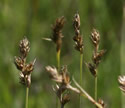 Carex praegracilis plants
Carex praegracilis plants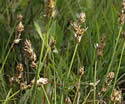 Carex praegracilis plants
Carex praegracilis plants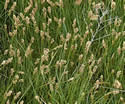 a colony of all-staminate plants
a colony of all-staminate plants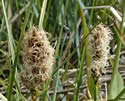 all-pistillate plants
all-pistillate plants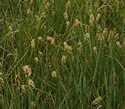 prairie swale habitat
prairie swale habitat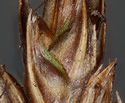 mature spike
mature spike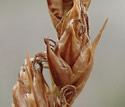 mature spike with reddish-brown scales
mature spike with reddish-brown scales
Photos by K. Chayka taken in South Dakota. Photos courtesy Peter M. Dziuk taken in Kittson and Renville counties and in South Dakota.
Comments
Have you seen this plant in Minnesota, or have any other comments about it?






